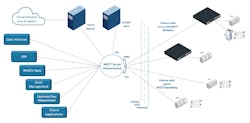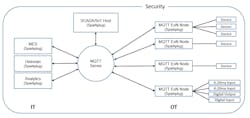When data related to production operations stayed within the realm of plant floor systems, common data tagging procedures for use by controllers or manufacturing execution systems were often sufficient for making the data transferrable and usable by other plant floor technologies. But the idea of digitization for Industrial Internet of Things (IIoT) or Industry 4.0 initiatives requires the data to be understood by systems outside of the plant floor.
To address this lack of data understandability across systems, Nipper says some companies are solving this problem by manually editing tags in multiple applications outside of OT. “But that process is time consuming, error prone, and inefficient,” he says.
A few months ago, Automation World reported on the launch of the Sparkplug Working Group. This group was designed to address the data transferrance issues noted by Nipper. More specifically, the Eclipse Foundation, which hosts the Sparkplug Working Group, describes the work of the group as being focused on “the definition of technical specifications and associated implementations that rationalize access to industrial data, improve the interoperability and scalability of IIoT solutions, and provide an overall framework for supporting Industry 4.0 for oil and gas, energy, manufacturing, smart cities, and other related industries.”
Nipper explains that Sparkplug is “an open source software specification that provides MQTT clients with a framework to integrate data. The specification articulates three goals:
- Define an MQTT Topic Namespace optimized for IIoT;
- Define MQTT State Management to take advantage of continuous session awareness; and
- Define the MQTT Payload.”
Nipper, who also happens to be one of the co-inventors of MQTT, provides another example to illustrate how Sparkplug can contextualize plant floor data for use by any system, anywhere. “Consider a Modbus protocol asking for register 40,027 returning a value of 2047. Most data consumers will have no idea what 2047 represents. Is it a temperature? Is it a pressure? With Sparkplug, instead of calling the register 40,027, it would say: compressor temperature, scale from 0 to 100 degrees Celsius, tied to ‘X’ asset device, is 27 degrees Celsius. With all of the necessary textual information for the data included, instead of one proprietary piece of data, it becomes shareable across the enterprise.”
Beyond the basic transferrance of data, Nipper notes that, with Sparkplug, machine learning and artificial intelligence applications can use the same standard interface for data without having to know and understand the entire OT environment. “They can subscribe to the OT data and use it immediately for IT functions,” he says.
For more information about the Sparkplug Working Group, visit https://sparkplug.eclipse.org.



